| Revision as of 18:55, 23 April 2009 view sourceSerendipodous (talk | contribs)Autopatrolled, Extended confirmed users, Pending changes reviewers, Rollbackers76,357 editsmNo edit summary← Previous edit | Revision as of 19:09, 23 April 2009 view source Ckatz (talk | contribs)Administrators82,942 edits clean up; thanks for the great startNext edit → | ||
| Line 2: | Line 2: | ||
| {{sprotect|small=yes}} | {{sprotect|small=yes}} | ||
| ]s and ]s of the Solar System. Sizes are to scale, but relative distances from the Sun are not.]] | ]s and ]s of the Solar System. Sizes are to scale, but relative distances from the Sun are not.]] | ||
| The '''Solar System'''{{Ref label|A|a|none}} consists of the ] and those ] |
The '''Solar System'''{{Ref label|A|a|none}} consists of the ] and those ] bound to it by ], all of which formed from the collapse of a ] approximately 4.5 billion years ago. The Sun's retinue of objects circle it in a nearly flat disc, most of the mass of which is contained within eight relatively solitary ] whose orbits are nearly circular. The four smaller inner planets; ], ], ] and ], also called the ], are primarily composed of rock and metal. The four outer planets, ], ], ] and ], also called the ], are composed largely of hydrogen and helium and are far more massive then the terrestrials. | ||
| Two main belts of ] exist. The ], which lies between Mars and Jupiter, has commonality with the terrestrial planets as it is composed mainly of rock and metal. The ] (and its subpopulation, the ]), which lies beyond Neptune's orbit, is composed mostly of ices such as water, ammonia and methane. Within these belts, five individual objects, ], ], ], ] and ], are recognised to be large enough to have been rounded by their own gravity, and are thus termed ]. The hypothetical ], which acts as the source for ]s, may also exist at a distance roughly a thousand times beyond these regions. | |||
| Within the Solar System, various populations of small bodies, such as ]s, ] and ], freely travel between these regions, while the ], a flow of ] from the Sun, creates a ] in the ] known as the ], which extends out to the middle of the scattered disc. | Within the Solar System, various populations of small bodies, such as ]s, ] and ], freely travel between these regions, while the ], a flow of ] from the Sun, creates a ] in the ] known as the ], which extends out to the middle of the scattered disc. | ||
Revision as of 19:09, 23 April 2009
This article is about the Sun and its planetary system. For other systems, see Planetary system and Star system.

The Solar System consists of the Sun and those celestial objects bound to it by gravity, all of which formed from the collapse of a giant molecular cloud approximately 4.5 billion years ago. The Sun's retinue of objects circle it in a nearly flat disc, most of the mass of which is contained within eight relatively solitary planets whose orbits are nearly circular. The four smaller inner planets; Mercury, Venus, Earth and Mars, also called the terrestrial planets, are primarily composed of rock and metal. The four outer planets, Jupiter, Saturn, Uranus and Neptune, also called the gas giants, are composed largely of hydrogen and helium and are far more massive then the terrestrials.
Two main belts of small bodies exist. The asteroid belt, which lies between Mars and Jupiter, has commonality with the terrestrial planets as it is composed mainly of rock and metal. The Kuiper belt (and its subpopulation, the Scattered disc), which lies beyond Neptune's orbit, is composed mostly of ices such as water, ammonia and methane. Within these belts, five individual objects, Ceres, Pluto, Haumea, Makemake and Eris, are recognised to be large enough to have been rounded by their own gravity, and are thus termed dwarf planets. The hypothetical Oort cloud, which acts as the source for long-period comets, may also exist at a distance roughly a thousand times beyond these regions.
Within the Solar System, various populations of small bodies, such as comets, centaurs and interplanetary dust, freely travel between these regions, while the solar wind, a flow of plasma from the Sun, creates a bubble in the interstellar medium known as the heliosphere, which extends out to the middle of the scattered disc.
Six of the planets and three of the dwarf planets are orbited by natural satellites, usually termed "moons" after Earth's Moon. Each of the outer planets is encircled by planetary rings of dust and other particles.
Discovery and exploration
Main article: Discovery and exploration of the Solar SystemFor many thousands of years, humanity, with a few notable exceptions, did not recognise the existence of the Solar System. They believed the Earth to be stationary at the centre of the universe and categorically different from the divine or ethereal objects that moved through the sky. Although the Indian mathematician-astronomer Aryabhata and the Greek philosopher Aristarchus of Samos had speculated on a heliocentric reordering of the cosmos, Nicolaus Copernicus was the first to develop a mathematically predictive heliocentric system. His 17th-century successors Galileo Galilei, Johannes Kepler, and Isaac Newton developed an understanding of physics which led to the gradual acceptance of the idea that the Earth moves around the Sun and that the planets are governed by the same physical laws that governed the Earth. In more recent times, this led to the investigation of geological phenomena such as mountains and craters and seasonal meteorological phenomena such as clouds, dust storms and ice caps on the other planets.
Structure
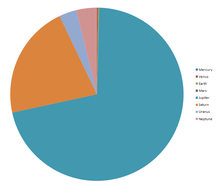

The principal component of the Solar System is the Sun, a main sequence G2 star that contains 99.86 percent of the system's known mass and dominates it gravitationally. Jupiter and Saturn, the Sun's two largest orbiting bodies, account for more than 90 percent of the system's remaining mass.
Most large objects in orbit around the Sun lie near the plane of Earth's orbit, known as the ecliptic. The planets are very close to the ecliptic while comets and Kuiper belt objects are usually at significantly greater angles to it.
All of the planets and most other objects also orbit with the Sun's rotation (counter-clockwise, as viewed from above the Sun's north pole). There are exceptions, such as Halley's Comet.
Kepler's laws of planetary motion describe the orbits of objects about the Sun. According to Kepler's laws, each object travels along an ellipse with the Sun at one focus. Objects closer to the Sun (with smaller semi-major axes) have shorter years. On an elliptical orbit, a body's distance from the Sun varies over the course of its year. A body's closest approach to the Sun is called its perihelion, while its most distant point from the Sun is called its aphelion. Each body moves fastest at its perihelion and slowest at its aphelion. The orbits of the planets are nearly circular, but many comets, asteroids and Kuiper belt objects follow highly elliptical orbits.
To cope with the vast distances involved, many representations of the Solar System show orbits the same distance apart. In reality, with a few exceptions, the farther a planet or belt is from the Sun, the larger the distance between it and the previous orbit. For example, Venus is approximately 0.33 astronomical units (AU) farther out than Mercury, while Saturn is 4.3 AU out from Jupiter, and Neptune lies 10.5 AU out from Uranus. Attempts have been made to determine a correlation between these orbital distances (see Titius-Bode law), but no such theory has been accepted.
Most of the planets in the Solar System possess secondary systems of their own. Many are in turn orbited by planetary objects called natural satellites, or moons, some of which are larger than planets. Most of the largest natural satellites are in synchronous orbit, with one face permanently turned toward their parent. The four largest planets also possess planetary rings, thin bands of tiny particles that orbit them in unison.
Terminology
Informally, the Solar System is sometimes divided into separate regions. The inner Solar System includes the four terrestrial planets and the main asteroid belt. The outer Solar System is beyond the asteroids, including the four gas giant planets. Since the discovery of the Kuiper belt, the outermost parts of the Solar System are considered a distinct region consisting of the objects beyond Neptune.
Dynamically and physically, objects orbiting the Sun are classed into three categories: planets, dwarf planets and small Solar System bodies. A planet is any body in orbit around the Sun that has enough mass to form itself into a spherical shape and has cleared its immediate neighbourhood of all smaller objects. By this definition, the Solar System has eight known planets: Mercury, Venus, Earth, Mars, Jupiter, Saturn, Uranus, and Neptune. Pluto does not fit this definition, as it has not cleared its orbit of surrounding Kuiper belt objects. A dwarf planet is a celestial body orbiting the Sun that is massive enough to be rounded by its own gravity but which has not cleared its neighbouring region of planetesimals and is not a satellite. By this definition, the Solar System has five known dwarf planets: Ceres, Pluto, Haumea, Makemake, and Eris. Other objects that may become classified as dwarf planets are Sedna, Orcus, and Quaoar. Dwarf planets that orbit in the trans-Neptunian region are called "plutoids". The remainder of the objects in orbit around the Sun are small Solar System bodies.
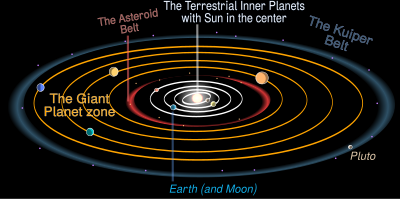
Planetary scientists use the terms gas, ice, and rock to describe the various classes of substances found throughout the Solar System. Rock is used to describe compounds with high melting points (greater than roughly 500 K), such as silicates. Rocky substances are prevalent in the inner Solar System, forming most of the terrestrial planets and asteroids. Gases are materials with low melting points such as atomic hydrogen, helium, and noble gases; they dominate the middle region, comprising most of Jupiter and Saturn. Ices, like water, methane, ammonia, and carbon dioxide, have melting points up to a few hundred Kelvin. Icy substances comprise the majority of the satellites of the giant planets, as well as most of Uranus and Neptune (the so-called "ice giants") and the numerous small objects that lie beyond Neptune's orbit. The term volatiles refers collectively to all materials with low boiling points (less than a few hundred kelvin), including gases and ices; depending on the temperature, volatiles can be found as ices, liquids, or gases in various places in the Solar System.
Sun
Main article: Sun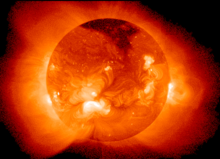
The Sun is the Solar System's star, and far and away its chief component. Its size is 332,830 Earth masses. This large mass gives it an interior density high enough to sustain nuclear fusion, which releases enormous amounts of energy, mostly radiated into space as electromagnetic radiation such as visible light.
The Sun is classified as a moderately large yellow dwarf, but this name is misleading as, compared to stars in our galaxy, the Sun is rather large and bright. Stars are classified by the Hertzsprung-Russell diagram, a graph which plots the brightness of stars against their surface temperatures. Generally, hotter stars are brighter. Stars following this pattern are said to be on the main sequence, and the Sun lies right in the middle of it. However, stars brighter and hotter than the Sun are rare, while dimmer and cooler stars are common.
It is believed that the Sun's position on the main sequence puts it in the "prime of life" for a star, in that it has not yet exhausted its store of hydrogen for nuclear fusion. The Sun is growing brighter; early in its history it was 70 percent as bright as it is today.
The Sun is a population I star; it was born in the later stages of the universe's evolution, and thus contains more elements heavier than hydrogen and helium ("metals" in astronomical parlance) than older population II stars. Elements heavier than hydrogen and helium were formed in the cores of ancient and exploding stars, so the first generation of stars had to die before the universe could be enriched with these atoms. The oldest stars contain few metals, while stars born later have more. This high metallicity is thought to have been crucial to the Sun's developing a planetary system, because planets form from accretion of metals.
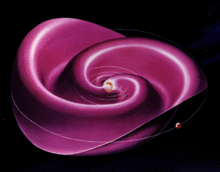
Interplanetary medium
Main article: Interplanetary mediumAlong with light, the Sun radiates a continuous stream of charged particles (a plasma) known as the solar wind. This stream of particles spreads outwards at roughly 1.5 million kilometres per hour, creating a tenuous atmosphere (the heliosphere) that permeates the Solar System out to at least 100 AU (see heliopause). This is known as the interplanetary medium. Geomagnetic storms on the Sun's surface, such as solar flares and coronal mass ejections, disturb the heliosphere, creating space weather. The largest structure within the heliosphere is the heliospheric current sheet, a spiral form created by the actions of the Sun's rotating magnetic field on the interplanetary medium.

Earth's magnetic field stops its atmosphere from being stripped away by the solar wind. Venus and Mars do not have magnetic fields, and the solar wind causes their atmospheres to gradually bleed away into space. The interaction of the solar wind with Earth's magnetic field funnels charged particles at right angles to the Earth's upper atmosphere, where its interactions create aurorae seen near the magnetic poles.
Cosmic rays originate outside the Solar System. The heliosphere partially shields the Solar System, and planetary magnetic fields (for those planets that have them) also provide some protection. The density of cosmic rays in the interstellar medium and the strength of the Sun's magnetic field change on very long timescales, so the level of cosmic radiation in the Solar System varies, though by how much is unknown.
The interplanetary medium is home to at least two disc-like regions of cosmic dust. The first, the zodiacal dust cloud, lies in the inner Solar System and causes zodiacal light. It was likely formed by collisions within the asteroid belt brought on by interactions with the planets. The second extends from about 10 AU to about 40 AU, and was probably created by similar collisions within the Kuiper belt.
Inner Solar System
The inner Solar System is the traditional name for the region comprising the terrestrial planets and asteroids. Composed mainly of silicates and metals, the objects of the inner Solar System huddle very closely to the Sun; the radius of this entire region is shorter than the distance between Jupiter and Saturn.
Inner planets
Main article: Terrestrial planet
The four inner or terrestrial planets have dense, rocky compositions, few or no moons, and no ring systems. They are composed largely of minerals with high melting points, such as the silicates which form their crusts and mantles, and metals such as iron and nickel, which form their cores. Three of the four inner planets (Venus, Earth and Mars) have substantial atmospheres; all have impact craters and tectonic surface features such as rift valleys and volcanoes. The term inner planet should not be confused with inferior planet, which designates those planets which are closer to the Sun than Earth is (i.e. Mercury and Venus).
Mercury
- Mercury (0.4 AU) is the closest planet to the Sun and the smallest planet (0.055 Earth masses). Mercury has no natural satellites, and its only known geological features besides impact craters are lobed ridges or rupes, probably produced by a period of contraction early in its history. Mercury's almost negligible atmosphere consists of atoms blasted off its surface by the solar wind. Its relatively large iron core and thin mantle have not yet been adequately explained. Hypotheses include that its outer layers were stripped off by a giant impact, and that it was prevented from fully accreting by the young Sun's energy.
Venus
- Venus (0.7 AU) is close in size to Earth, (0.815 Earth masses) and like Earth, has a thick silicate mantle around an iron core, a substantial atmosphere and evidence of internal geological activity. However, it is much drier than Earth and its atmosphere is ninety times as dense. Venus has no natural satellites. It is the hottest planet, with surface temperatures over 400 °C, most likely due to the amount of greenhouse gases in the atmosphere. No definitive evidence of current geological activity has been detected on Venus, but it has no magnetic field that would prevent depletion of its substantial atmosphere, which suggests that its atmosphere is regularly replenished by volcanic eruptions.
Earth
- Earth (1 AU) is the largest and densest of the inner planets, the only one known to have current geological activity, and the only planet known to have life. Its liquid hydrosphere is unique among the terrestrial planets, and it is also the only planet where plate tectonics has been observed. Earth's atmosphere is radically different from those of the other planets, having been altered by the presence of life to contain 21% free oxygen. It has one natural satellite, the Moon (Latin: Luna), the only large satellite of a terrestrial planet in the Solar System.
Mars
- Mars (1.5 AU) is smaller than Earth and Venus (0.107 Earth masses). It possesses a tenuous atmosphere of mostly carbon dioxide. Its surface, peppered with vast volcanoes such as Olympus Mons and rift valleys such as Valles Marineris, shows geological activity that may have persisted until very recently. Its red color comes from rust in its iron-rich soil. Mars has two tiny natural satellites (Deimos and Phobos) thought to be captured asteroids.
Asteroid belt
Main article: Asteroid belt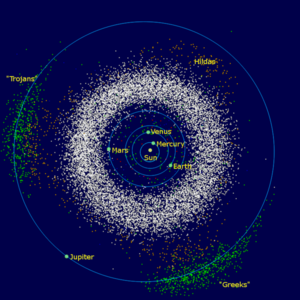
Asteroids are mostly small Solar System bodies composed mainly of rocky and metallic non-volatile minerals.
The main asteroid belt occupies the orbit between Mars and Jupiter, between 2.3 and 3.3 AU from the Sun. It is thought to be remnants from the Solar System's formation that failed to coalesce because of the gravitational interference of Jupiter.
Asteroids range in size from hundreds of kilometres across to microscopic. All asteroids save the largest, Ceres, are classified as small Solar System bodies, but some asteroids such as Vesta and Hygieia may be reclassed as dwarf planets if they are shown to have achieved hydrostatic equilibrium.
The asteroid belt contains tens of thousands, possibly millions, of objects over one kilometre in diameter. Despite this, the total mass of the main belt is unlikely to be more than a thousandth of that of the Earth. The main belt is very sparsely populated; spacecraft routinely pass through without incident. Asteroids with diameters between 10 and 10 m are called meteoroids.
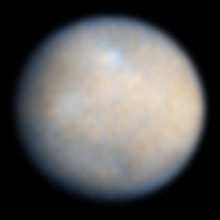
Ceres
- Ceres (2.77 AU) is the largest body in the asteroid belt and is classified as a dwarf planet. It has a diameter of slightly under 1000 km, large enough for its own gravity to pull it into a spherical shape. Ceres was considered a planet when it was discovered in the 19th century, but was reclassified as an asteroid in the 1850s as further observation revealed additional asteroids. It was again reclassified in 2006 as a dwarf planet.
Asteroid groups
- Asteroids in the main belt are divided into asteroid groups and families based on their orbital characteristics. Asteroid moons are asteroids that orbit larger asteroids. They are not as clearly distinguished as planetary moons, sometimes being almost as large as their partners. The asteroid belt also contains main-belt comets which may have been the source of Earth's water.
Trojan asteroids are located in either of Jupiter's L4 or L5 points (gravitationally stable regions leading and trailing a planet in its orbit); the term "Trojan" is also used for small bodies in any other planetary or satellite Lagrange point. Hilda asteroids are in a 2:3 resonance with Jupiter; that is, they go around the Sun three times for every two Jupiter orbits.
The inner Solar System is also dusted with rogue asteroids, many of which cross the orbits of the inner planets.
Outer Solar System
The outer region of the Solar System is home to the gas giants and their planet-sized satellites. Many short period comets, including the centaurs, also orbit in this region. The solid objects in this region are composed of a higher proportion of volatiles (such as water, ammonia, methane, often called ices in planetary science) than the rocky denizens of the inner Solar System.
Outer planets
Main article: Gas giant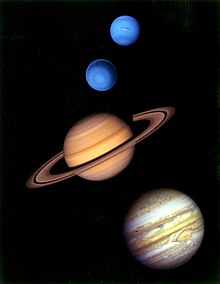
The four outer planets, or gas giants (sometimes called Jovian planets), collectively make up 99 percent of the mass known to orbit the Sun. Jupiter and Saturn consist overwhelmingly of hydrogen and helium; Uranus and Neptune possess a greater proportion of ices in their makeup. Some astronomers suggest they belong in their own category, “ice giants.” All four gas giants have rings, although only Saturn's ring system is easily observed from Earth. The term outer planet should not be confused with superior planet, which designates planets outside Earth's orbit (the outer planets and Mars).
Jupiter
- Jupiter (5.2 AU), at 318 Earth masses, is 2.5 times all the mass of all the other planets put together. It is composed largely of hydrogen and helium. Jupiter's strong internal heat creates a number of semi-permanent features in its atmosphere, such as cloud bands and the Great Red Spot. Jupiter has sixty-three known satellites. The four largest, Ganymede, Callisto, Io, and Europa, show similarities to the terrestrial planets, such as volcanism and internal heating. Ganymede, the largest satellite in the Solar System, is larger than Mercury.
Saturn
- Saturn (9.5 AU), distinguished by its extensive ring system, has several similarities to Jupiter, such as its atmospheric composition and magnetosphere. Although Saturn has 60% of Jupiter's volume, it is less than a third as massive, at 95 Earth masses, making it the least dense planet in the Solar System. Saturn has sixty known satellites (and three unconfirmed); two of which, Titan and Enceladus, show signs of geological activity, though they are largely made of ice. Titan is larger than Mercury and the only satellite in the Solar System with a substantial atmosphere.
Uranus
- Uranus (19.6 AU), at 14 Earth masses, is the lightest of the outer planets. Uniquely among the planets, it orbits the Sun on its side; its axial tilt is over ninety degrees to the ecliptic. It has a much colder core than the other gas giants, and radiates very little heat into space. Uranus has twenty-seven known satellites, the largest ones being Titania, Oberon, Umbriel, Ariel and Miranda.
Neptune
- Neptune (30 AU), though slightly smaller than Uranus, is more massive (equivalent to 17 Earths) and therefore more dense. It radiates more internal heat, but not as much as Jupiter or Saturn. Neptune has thirteen known satellites. The largest, Triton, is geologically active, with geysers of liquid nitrogen. Triton is the only large satellite with a retrograde orbit. Neptune is accompanied in its orbit by a number of minor planets, termed Neptune Trojans, that are in 1:1 resonance with it.
Comets
Main article: Comet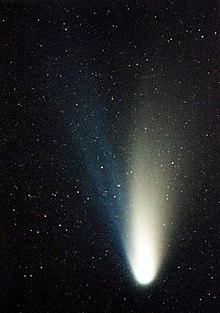
Comets are small Solar System bodies, usually only a few kilometres across, composed largely of volatile ices. They have highly eccentric orbits, generally a perihelion within the orbits of the inner planets and an aphelion far beyond Pluto. When a comet enters the inner Solar System, its proximity to the Sun causes its icy surface to sublimate and ionise, creating a coma: a long tail of gas and dust often visible to the naked eye.
Short-period comets have orbits lasting less than two hundred years. Long-period comets have orbits lasting thousands of years. Short-period comets are believed to originate in the Kuiper belt, while long-period comets, such as Hale-Bopp, are believed to originate in the Oort cloud. Many comet groups, such as the Kreutz Sungrazers, formed from the breakup of a single parent. Some comets with hyperbolic orbits may originate outside the Solar System, but determining their precise orbits is difficult. Old comets that have had most of their volatiles driven out by solar warming are often categorised as asteroids.
Centaurs
The centaurs are icy comet-like bodies with a semi-major axis greater than Jupiter (5.5 AU) and less than Neptune (30 AU). The largest known centaur, 10199 Chariklo, has a diameter of about 250 km. The first centaur discovered, 2060 Chiron, has also been classified as comet (95P) since it develops a coma just as comets do when they approach the Sun. Some astronomers classify centaurs as inward-scattered Kuiper belt objects along with the outward-scattered residents of the scattered disc.
Trans-Neptunian region
The area beyond Neptune, or the "trans-Neptunian region", is still largely unexplored. It appears to consist overwhelmingly of small worlds (the largest having a diameter only a fifth that of the Earth and a mass far smaller than that of the Moon) composed mainly of rock and ice. This region is sometimes known as the "outer Solar System", though others use that term to mean the region beyond the asteroid belt.
Kuiper belt
Main article: Kuiper belt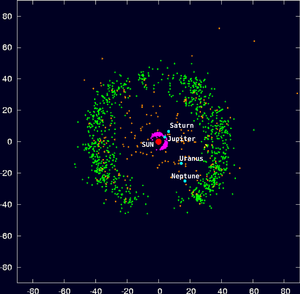
The Kuiper belt, the region's first formation, is a great ring of debris similar to the asteroid belt, but composed mainly of ice. It extends between 30 and 50 AU from the Sun. It is composed mainly of small Solar System bodies, but many of the largest Kuiper belt objects, such as Quaoar, Varuna, and Orcus, may be reclassified as dwarf planets. There are estimated to be over 100,000 Kuiper belt objects with a diameter greater than 50 km, but the total mass of the Kuiper belt is thought to be only a tenth or even a hundredth the mass of the Earth. Many Kuiper belt objects have multiple satellites, and most have orbits that take them outside the plane of the ecliptic.

The Kuiper belt can be roughly divided into the "classical" belt and the resonances. Resonances are orbits linked to that of Neptune (e.g. twice for every three Neptune orbits, or once for every two). The first resonance actually begins within the orbit of Neptune itself. The classical belt consists of objects having no resonance with Neptune, and extends from roughly 39.4 AU to 47.7 AU. Members of the classical Kuiper belt are classified as cubewanos, after the first of their kind to be discovered, (15760) 1992 QB1.
Pluto and Charon
- Pluto (39 AU average), a dwarf planet, is the largest known object in the Kuiper belt. When discovered in 1930, it was considered to be the ninth planet; this changed in 2006 with the adoption of a formal definition of planet. Pluto has a relatively eccentric orbit inclined 17 degrees to the ecliptic plane and ranging from 29.7 AU from the Sun at perihelion (within the orbit of Neptune) to 49.5 AU at aphelion.
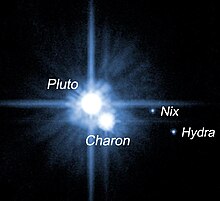
- It is unclear whether Charon, Pluto's largest moon, will continue to be classified as such or as a dwarf planet itself. Both Pluto and Charon orbit a barycenter of gravity above their surfaces, making Pluto-Charon a binary system. Two much smaller moons, Nix and Hydra, orbit Pluto and Charon.
- Pluto lies in the resonant belt and has a 3:2 resonance with Neptune, meaning that Pluto orbits twice round the Sun for every three Neptunian orbits. Kuiper belt objects whose orbits share this resonance are called plutinos.
Haumea and Makemake
- Haumea (43.34 AU average), and Makemake (45.79 AU average) are the largest known objects in the classical Kuiper belt. Haumea is an egg-shaped object with two moons. Makemake is the brightest object in the Kuiper belt after Pluto. Originally designated 2003 EL61 and 2005 FY9 respectively, they were granted names (and the status of dwarf planet) in 2008. Their orbits are far more inclined than Pluto's (28° and 29°) and unlike Pluto are not affected by Neptune, being part of the classical KBO population.
Scattered disc
Main article: Scattered disc
The scattered disc overlaps the Kuiper belt but extends much further outwards. This region is thought to be the source of short-period comets. Scattered disc objects are believed to have been ejected into erratic orbits by the gravitational influence of Neptune's early outward migration. Most scattered disc objects (SDOs) have perihelia within the Kuiper belt but aphelia as far as 150 AU from the Sun. SDOs' orbits are also highly inclined to the ecliptic plane, and are often almost perpendicular to it. Some astronomers consider the scattered disc to be merely another region of the Kuiper belt, and describe scattered disc objects as "scattered Kuiper belt objects."
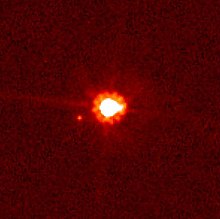
Eris
- Eris (68 AU average) is the largest known scattered disc object, and caused a debate about what constitutes a planet, since it is at least 5% larger than Pluto with an estimated diameter of 2400 km (1500 mi). It is the largest of the known dwarf planets. It has one moon, Dysnomia. Like Pluto, its orbit is highly eccentric, with a perihelion of 38.2 AU (roughly Pluto's distance from the Sun) and an aphelion of 97.6 AU, and steeply inclined to the ecliptic plane.
Farthest regions
The point at which the Solar System ends and interstellar space begins is not precisely defined, since its outer boundaries are shaped by two separate forces: the solar wind and the Sun's gravity. The outer limit of the solar wind's influence is roughly four times Pluto's distance from the Sun; this heliopause is considered the beginning of the interstellar medium. However, the Sun's Roche sphere, the effective range of its gravitational influence, is believed to extend up to a thousand times farther.
Heliopause

The heliosphere is divided into two separate regions. The solar wind travels at roughly 400 km/s until it collides with flows of plasma in the interstellar medium. The collision occurs at the termination shock, which is roughly 80–100 AU from the Sun in the upwind direction and roughly 200 AU from the Sun downwind. Here the wind slows dramatically, condenses and becomes more turbulent, forming a great oval structure known as the heliosheath that looks and behaves very much like a comet's tail, extending outward for a further 40 AU on the upwind side but tailing many times that distance in the opposite direction. Both Voyager 1 and Voyager 2 are reported to have passed the termination shock and entered the heliosheath, at 94 and 84 AU from the Sun, respectively. The outer boundary of the heliosphere, the heliopause, is the point at which the solar wind finally terminates and is the beginning of interstellar space.
The shape and form of the outer edge of the heliosphere is likely affected by the fluid dynamics of interactions with the interstellar medium as well as solar magnetic fields prevailing to the south, e.g. it is bluntly shaped with the northern hemisphere extending 9 AU (roughly 900 million miles) farther than the southern hemisphere. Beyond the heliopause, at around 230 AU, lies the bow shock, a plasma "wake" left by the Sun as it travels through the Milky Way.
No spacecraft have yet passed beyond the heliopause, so it is impossible to know for certain the conditions in local interstellar space. It is expected that NASA's Voyager spacecraft will pass the heliopause some time in the next decade and transmit valuable data on radiation levels and solar wind back to the Earth. How well the heliosphere shields the Solar System from cosmic rays is poorly understood. A NASA-funded team has developed a concept of a "Vision Mission" dedicated to sending a probe to the heliosphere.
Oort cloud
Main article: Oort cloud
The hypothetical Oort cloud is a great mass of up to a trillion icy objects that is believed to be the source for all long-period comets and to surround the Solar System at roughly 50,000 AU (around 1 light-year (LY)), and possibly to as far as 100,000 AU (1.87 LY). It is believed to be composed of comets which were ejected from the inner Solar System by gravitational interactions with the outer planets. Oort cloud objects move very slowly, and can be perturbed by infrequent events such as collisions, the gravitational effects of a passing star, or the galactic tide, the tidal force exerted by the Milky Way.

Sedna
90377 Sedna (525.86 AU average) is a large, reddish Pluto-like object with a gigantic, highly elliptical orbit that takes it from about 76 AU at perihelion to 928 AU at aphelion and takes 12,050 years to complete. Mike Brown, who discovered the object in 2003, asserts that it cannot be part of the scattered disc or the Kuiper belt as its perihelion is too distant to have been affected by Neptune's migration. He and other astronomers consider it to be the first in an entirely new population, which also may include the object 2000 CR105, which has a perihelion of 45 AU, an aphelion of 415 AU, and an orbital period of 3,420 years. Brown terms this population the "Inner Oort cloud," as it may have formed through a similar process, although it is far closer to the Sun. Sedna is very likely a dwarf planet, though its shape has yet to be determined with certainty.
Boundaries
See also: Vulcanoid asteroid, Planets beyond Neptune, and Nemesis (star)Much of our Solar System is still unknown. The Sun's gravitational field is estimated to dominate the gravitational forces of surrounding stars out to about two light years (125,000 AU). Lower estimates for the radius of the Oort cloud, by contrast, do not place it farther than 50,000 AU. Despite discoveries such as Sedna, the region between the Kuiper belt and the Oort cloud, an area tens of thousands of AU in radius, is still virtually unmapped. There are also ongoing studies of the region between Mercury and the Sun. Objects may yet be discovered in the Solar System's uncharted regions.
Galactic context

The Solar System is located in the Milky Way galaxy, a barred spiral galaxy with a diameter of about 100,000 light-years containing about 200 billion stars. Our Sun resides in one of the Milky Way's outer spiral arms, known as the Orion Arm or Local Spur. The Sun lies between 25,000 and 28,000 light years from the Galactic Centre, and its speed within the galaxy is about 220 kilometres per second, so that it completes one revolution every 225–250 million years. This revolution is known as the Solar System's galactic year. The solar apex, the direction of the Sun's path through interstellar space, is near the constellation of Hercules in the direction of the current location of the bright star Vega.
The Solar System's location in the galaxy is very likely a factor in the evolution of life on Earth. Its orbit is close to being circular and is at roughly the same speed as that of the spiral arms, which means it passes through them only rarely. Since spiral arms are home to a far larger concentration of potentially dangerous supernovae, this has given Earth long periods of interstellar stability for life to evolve. The Solar System also lies well outside the star-crowded environs of the galactic centre. Near the centre, gravitational tugs from nearby stars could perturb bodies in the Oort Cloud and send many comets into the inner Solar System, producing collisions with potentially catastrophic implications for life on Earth. The intense radiation of the galactic centre could also interfere with the development of complex life. Even at the Solar System's current location, some scientists have hypothesised that recent supernovae may have adversely affected life in the last 35,000 years by flinging pieces of expelled stellar core towards the Sun in the form of radioactive dust grains and larger, comet-like bodies.
Neighbourhood

The immediate galactic neighbourhood of the Solar System is known as the Local Interstellar Cloud or Local Fluff, an area of dense cloud in an otherwise sparse region known as the Local Bubble, an hourglass-shaped cavity in the interstellar medium roughly 300 light years across. The bubble is suffused with high-temperature plasma that suggests it is the product of several recent supernovae.
There are relatively few stars within ten light years (95 trillion km) of the Sun. The closest is the triple star system Alpha Centauri, which is about 4.4 light years away. Alpha Centauri A and B are a closely tied pair of Sun-like stars, while the small red dwarf Alpha Centauri C (also known as Proxima Centauri) orbits the pair at a distance of 0.2 light years. The stars next closest to the Sun are the red dwarfs Barnard's Star (at 5.9 light years), Wolf 359 (7.8 light years) and Lalande 21185 (8.3 light years). The largest star within ten light years is Sirius, a bright main sequence star roughly twice the Sun's mass and orbited by a white dwarf called Sirius B. It lies 8.6 light years away. The remaining systems within ten light years are the binary red dwarf system Luyten 726-8 (8.7 light years) and the solitary red dwarf Ross 154 (9.7 light years). Our closest solitary sun-like star is Tau Ceti, which lies 11.9 light years away. It has roughly 80 percent the Sun's mass, but only 60 percent its luminosity. The closest known extrasolar planet to the Sun lies around the star Epsilon Eridani, a star slightly dimmer and redder than the Sun, which lies 10.5 light years away. Its one confirmed planet, Epsilon Eridani b, is roughly 1.5 times Jupiter's mass and orbits its star every 6.9 years.
Formation and evolution
| Isotope | Nuclei per Million |
|---|---|
| Hydrogen-1 | 705,700 |
| Helium-4 | 275,200 |
| Oxygen-16 | 5,920 |
| Carbon-12 | 3,032 |
| Neon-20 | 1,548 |
| Iron-56 | 1,169 |
| Nitrogen-14 | 1,105 |
| Silicon-28 | 653 |
| Magnesium-24 | 513 |
| Sulfur-32 | 396 |
| Neon-22 | 208 |
| Magnesium-26 | 79 |
| Argon-36 | 77 |
| Iron-54 | 72 |
| Magnesium-25 | 69 |
| Calcium-40 | 60 |
| Aluminum-27 | 58 |
| Nickel-58 | 49 |
| Carbon-13 | 37 |
| Helium-3 | 35 |
| Silicon-29 | 34 |
| Sodium-23 | 33 |
| Iron-57 | 28 |
| Hydrogen-2 | 23 |
| Silicon-30 | 23 |

The Solar System formed from the gravitational collapse of a giant molecular cloud 4.6 billion years ago. This initial cloud was likely several light-years across and probably birthed several stars.
As the region that would become the Solar System, known as the pre-solar nebula, collapsed, conservation of angular momentum made it rotate faster. The centre, where most of the mass collected, became increasingly hotter than the surrounding disc. As the contracting nebula rotated, it began to flatten into a spinning protoplanetary disc with a diameter of roughly 200 AU and a hot, dense protostar at the centre. At this point in its evolution, the Sun is believed to have been a T Tauri star. Studies of T Tauri stars show that they are often accompanied by discs of pre-planetary matter with masses of 0.001–0.1 solar masses, with the vast majority of the mass of the nebula in the star itself. The planets formed by accretion from this disk.
Within 50 million years, the pressure and density of hydrogen in the centre of the protostar became great enough for it to begin thermonuclear fusion. The temperature, reaction rate, pressure, and density increased until hydrostatic equilibrium was achieved, with the thermal energy countering the force of gravitational contraction. At this point the Sun became a full-fledged main sequence star.

The Solar System as we know it today will last until the Sun begins its evolution off of the main sequence of the Hertzsprung-Russell diagram. As the Sun burns through its supply of hydrogen fuel, the energy output supporting the core tends to decrease, causing it to collapse in on itself. This increase in pressure heats the core, so it burns even faster. As a result, the Sun is growing brighter at a rate of roughly ten percent every 1.1 billion years.
Around 5.4 billion years from now, the hydrogen in the core of the Sun will have been entirely converted to helium, ending the main sequence phase. At this time, the outer layers of the Sun will expand to roughly up to 260 times its current diameter; the Sun will become a red giant. Because of its vastly increased surface area, the surface of the Sun will be considerably cooler than it is on the main sequence (2600 K at the coolest).
Eventually, the Sun's outer layers will fall away, leaving a white dwarf, an extraordinarily dense object, half the original mass of the Sun but only the size of the Earth. The ejected outer layers will form what is known as a planetary nebula, returning some of the material that formed the Sun to the interstellar medium.
See also
- Astronomical symbols
- Celestia – 3D computer space-simulation program
- Family Portrait (Voyager)
- Geological features of the solar system
- List of Solar System objects:
- New Horizons
- Numerical model of solar system
- Physical and orbital data on the Sun, planets, dwarf planets, and moons
- Pioneer 10
- Pioneer 11
- Solar System in fiction
- Solar system model
- Space colonization
- Voyager program
Notes
- Capitalization of the name varies. The IAU, the authoritative body regarding astronomical nomenclature, specifies capitalizing the names of all individual astronomical objects (Solar System). However, the name is commonly rendered in lower case (solar system) including in the Oxford English Dictionary, Merriam-Webster's 11th Collegiate Dictionary, and Encyclopædia Britannica.
- See List of moons for the full list of natural satellites of the eight planets and five dwarf planets.
- The mass of the Solar System excluding the Sun, Jupiter and Saturn can be determined by adding together all the calculated masses for its largest objects and using rough calculations for the masses of the Oort cloud (estimated at roughly 3 Earth masses), the Kuiper Belt (estimated at roughly 0.1 Earth mass) and the asteroid belt (estimated to be 0.0005 Earth mass) for a total, rounded upwards, of ~37 Earth masses, or 8.1 percent the mass in orbit around the Sun. With the combined masses of Uranus and Neptune (~31 Earth masses) subtracted, the remaining ~6 Earth masses of material comprise 1.3 percent of the total.
- Astronomers usually measure distances within the Solar System in astronomical units (AU). One AU is approximately the average distance between the Earth and the Sun, or 149,598,000 km (92,956,000 mi). Pluto is roughly 38 AU from the Sun, while Jupiter lies at roughly 5.2 AU. One light-year is 63,240 AU.
References
- M Woolfson (2000). "The origin and evolution of the solar system". Astronomy & Geophysics. 41: 1.12. doi:10.1046/j.1468-4004.2000.00012.x.
- nineplanets.org. "An Overview of the Solar System". Retrieved 2007-02-15.
- Amir Alexander (2006). "New Horizons Set to Launch on 9-Year Voyage to Pluto and the Kuiper Belt". The Planetary Society. Retrieved 2006-11-08.
- ^ "The Final IAU Resolution on the definition of "planet" ready for voting". IAU. 2006-08-24. Retrieved 2007-03-02.
- ^ "Dwarf Planets and their Systems". Working Group for Planetary System Nomenclature (WGPSN). U.S. Geological Survey. 2008-11-07. Retrieved 2008-07-13.
- "Plutoid chosen as name for Solar System objects like Pluto". International Astronomical Union (News Release - IAU0804). June 11, 2008, Paris. Retrieved 2008-06-11.
{{cite web}}: Check date values in:|date=(help) - Feaga, L (2007). "Asymmetries in the distribution of H2O and CO2 in the inner coma of Comet 9P/Tempel 1 as observed by Deep Impact". Icarus. 190: 345. Bibcode:2007Icar..190..345F. doi:10.1016/j.icarus.2007.04.009.
- Michael Zellik (2002). Astronomy: The Evolving Universe (9th ed.). Cambridge University Press. p. 240. ISBN 0521800900. OCLC 223304585 46685453.
{{cite book}}: Check|oclc=value (help) - Smart, R. L.; Carollo, D.; Lattanzi, M. G.; McLean, B.; Spagna, A. (2001). "The Second Guide Star Catalogue and Cool Stars". Perkins Observatory. Retrieved 2006-12-26.
{{cite web}}: CS1 maint: multiple names: authors list (link) - Nir J. Shaviv (2003). "Towards a Solution to the Early Faint Sun Paradox: A Lower Cosmic Ray Flux from a Stronger Solar Wind". Journal of Geophysical Research. 108: 1437. doi:10.1029/2003JA009997. Retrieved 2009-01-26.
- T. S. van Albada, Norman Baker (1973). "On the Two Oosterhoff Groups of Globular Clusters". Astrophysical Journal. 185: 477–498. doi:10.1086/152434.
- Charles H. Lineweaver (2001-03-09). "An Estimate of the Age Distribution of Terrestrial Planets in the Universe: Quantifying Metallicity as a Selection Effect". University of New South Wales. Retrieved 2006-07-23.
- "Solar Physics: The Solar Wind". Marshall Space Flight Center. 2006-07-16. Retrieved 2006-10-03.
- Phillips, Tony (2001-02-15). "The Sun Does a Flip". Science@NASA. Retrieved 2007-02-04.
- A Star with two North Poles, April 22, 2003, Science @ NASA
- Riley, Pete; Linker, J. A.; Mikić, Z., "Modeling the heliospheric current sheet: Solar cycle variations", (2002) Journal of Geophysical Research (Space Physics), Volume 107, Issue A7, pp. SSH 8-1, CiteID 1136, DOI 10.1029/2001JA000299. (Full text)
- Template:Cite science
- Langner, U. W. (2005). "Effects of the position of the solar wind termination shock and the heliopause on the heliospheric modulation of cosmic rays". Advances in Space Research. 35 (12): 2084–2090. doi:10.1016/j.asr.2004.12.005. Retrieved 2007-02-11.
{{cite journal}}: Unknown parameter|coauthors=ignored (|author=suggested) (help) - "Long-term Evolution of the Zodiacal Cloud". 1998. Retrieved 2007-02-03.
- "ESA scientist discovers a way to shortlist stars that might have planets". ESA Science and Technology. 2003. Retrieved 2007-02-03.
- Landgraf, M. (2002). "Origins of Solar System Dust beyond Jupiter". The Astronomical Journal. 123 (5): 2857–2861. doi:10.1086/339704. Retrieved 2007-02-09.
{{cite journal}}: Unknown parameter|coauthors=ignored (|author=suggested) (help); Unknown parameter|month=ignored (help) - Schenk P., Melosh H.J. (1994), Lobate Thrust Scarps and the Thickness of Mercury's Lithosphere, Abstracts of the 25th Lunar and Planetary Science Conference, 1994LPI....25.1203S
- Bill Arnett (2006). "Mercury". The Nine Planets. Retrieved 2006-09-14.
- Benz, W., Slattery, W. L., Cameron, A. G. W. (1988), Collisional stripping of Mercury's mantle, Icarus, v. 74, p. 516–528.
- Cameron, A. G. W. (1985), The partial volatilization of Mercury, Icarus, v. 64, p. 285–294.
- Mark Alan Bullock (1997). "The Stability of Climate on Venus" (PDF). Southwest Research Institute. Retrieved 2006-12-26.
{{cite journal}}: Cite journal requires|journal=(help) - Paul Rincon (1999). "Climate Change as a Regulator of Tectonics on Venus" (PDF). Johnson Space Center Houston, TX, Institute of Meteoritics, University of New Mexico, Albuquerque, NM. Retrieved 2006-11-19.
- Anne E. Egger, M.A./M.S. "Earth's Atmosphere: Composition and Structure". VisionLearning.com. Retrieved 2006-12-26.
- David Noever (2004). "Modern Martian Marvels: Volcanoes?". NASA Astrobiology Magazine. Retrieved 2006-07-23.
- Scott S. Sheppard, David Jewitt, and Jan Kleyna (2004). "A Survey for Outer Satellites of Mars: Limits to Completeness". The Astronomical Journal. Retrieved 2006-12-26.
{{cite web}}: CS1 maint: multiple names: authors list (link) - "Are Kuiper Belt Objects asteroids? Are large Kuiper Belt Objects planets?". Cornell University. Retrieved 2009-03-01.
- Petit, J.-M.; Morbidelli, A.; Chambers, J. (2001). "The Primordial Excitation and Clearing of the Asteroid Belt" (PDF). Icarus. 153: 338–347. doi:10.1006/icar.2001.6702. Retrieved 2007-03-22.
{{cite journal}}: CS1 maint: multiple names: authors list (link) - "IAU Planet Definition Committee". International Astronomical Union. 2006. Retrieved 2009-03-01.
- "New study reveals twice as many asteroids as previously believed". ESA. 2002. Retrieved 2006-06-23.
- ^ Krasinsky, G. A. (2002). "Hidden Mass in the Asteroid Belt". Icarus. 158 (1): 98–105. doi:10.1006/icar.2002.6837.
{{cite journal}}: Unknown parameter|coauthors=ignored (|author=suggested) (help); Unknown parameter|month=ignored (help) - Beech, M. (1995). "On the Definition of the Term Meteoroid". Quarterly Journal of the Royal Astronomical Society. 36 (3): 281–284. Retrieved 2006-08-31.
{{cite journal}}: Unknown parameter|coauthors=ignored (|author=suggested) (help); Unknown parameter|month=ignored (help) - "History and Discovery of Asteroids" (DOC). NASA. Retrieved 2006-08-29.
- Phil Berardelli (2006). "Main-Belt Comets May Have Been Source Of Earths Water". SpaceDaily. Retrieved 2006-06-23.
- Jack J. Lissauer, David J. Stevenson (2006). "Formation of Giant Planets" (PDF). NASA Ames Research Center; California Institute of Technology. Retrieved 2006-01-16.
- Pappalardo, R T (1999). "Geology of the Icy Galilean Satellites: A Framework for Compositional Studies". Brown University. Retrieved 2006-01-16.
- J. S. Kargel (1994). "Cryovolcanism on the icy satellites". U.S. Geological Survey. Retrieved 2006-01-16.
- Hawksett, David; Longstaff, Alan; Cooper, Keith; Clark, Stuart (2005). "10 Mysteries of the Solar System". Astronomy Now. Retrieved 2006-01-16.
{{cite web}}: CS1 maint: multiple names: authors list (link) - Podolak, M.; Reynolds, R. T.; Young, R. (1990). "Post Voyager comparisons of the interiors of Uranus and Neptune". NASA, Ames Research Center. Retrieved 2006-01-16.
{{cite web}}: CS1 maint: multiple names: authors list (link) - Duxbury, N.S., Brown, R.H. (1995). "The Plausibility of Boiling Geysers on Triton". Beacon eSpace. Retrieved 2006-01-16.
{{cite web}}: CS1 maint: multiple names: authors list (link) - Sekanina, Zdenek (2001). "Kreutz sungrazers: the ultimate case of cometary fragmentation and disintegration?". Publications of the Astronomical Institute of the Academy of Sciences of the Czech Republic. 89 p.78–93.
- Królikowska, M. (2001). "A study of the original orbits of hyperbolic comets". Astronomy & Astrophysics. 376 (1): 316–324. doi:10.1051/0004-6361:20010945. Retrieved 2007-01-02.
- Fred L. Whipple (1992-04). "The activities of comets related to their aging and origin". Retrieved 2006-12-26.
{{cite web}}: Check date values in:|date=(help) - John Stansberry, Will Grundy, Mike Brown, Dale Cruikshank, John Spencer, David Trilling, Jean-Luc Margot (2007). "Physical Properties of Kuiper Belt and Centaur Objects: Constraints from Spitzer Space Telescope". Retrieved 2008-09-21.
{{cite web}}: CS1 maint: multiple names: authors list (link) - Patrick Vanouplines (1995). "Chiron biography". Vrije Universitiet Brussel. Retrieved 2006-06-23.
- "List Of Centaurs and Scattered-Disk Objects". IAU: Minor Planet Center. Retrieved 2007-04-02.
- ^ Audrey Delsanti and David Jewitt (2006). "The Solar System Beyond The Planets" (PDF). Institute for Astronomy, University of Hawaii. Retrieved 2007-01-03.
- M. W. Buie, R. L. Millis, L. H. Wasserman, J. L. Elliot, S. D. Kern, K. B. Clancy, E. I. Chiang, A. B. Jordan, K. J. Meech, R. M. Wagner, D. E. Trilling (2005). "Procedures, Resources and Selected Results of the Deep Ecliptic Survey". Lowell Observatory, University of Pennsylvania, Large Binocular Telescope Observatory, Massachusetts Institute of Technology, University of Hawaii, University of California at Berkeley. Retrieved 2006-09-07.
{{cite web}}: CS1 maint: multiple names: authors list (link) - E. Dotto1, M.A. Barucci2, and M. Fulchignoni (2006-08-24). "Beyond Neptune, the new frontier of the Solar System" (PDF). Retrieved 2006-12-26.
{{cite web}}: CS1 maint: multiple names: authors list (link) CS1 maint: numeric names: authors list (link) - Template:Cite science
- Marc W. Buie (2008-04-05). "Orbit Fit and Astrometric record for 136472". SwRI (Space Science Department). Retrieved 2008-07-13.
- David Jewitt (2005). "The 1000 km Scale KBOs". University of Hawaii. Retrieved 2006-07-16.
- Mike Brown (2005). "The discovery of
2003 UB313Eris, the10th planetlargest known dwarf planet". CalTech. Retrieved 2006-09-15. - ^ "Voyager Enters Solar System's Final Frontier". NASA. Retrieved 2007-04-02.
- ^ Fahr, H. J.; Kausch, T.; Scherer, H. (2000). "A 5-fluid hydrodynamic approach to model the Solar System-interstellar medium interaction" (PDF). Astronomy & Astrophysics. 357: 268. Bibcode:2000A&A...357..268F.
{{cite journal}}: CS1 maint: multiple names: authors list (link) See Figures 1 and 2. - Stone, E. C.; Cummings, A. C.; McDonald, F. B.; Heikkila, B. C.; Lal, N.; Webber, W. R. (2005). "Voyager 1 explores the termination shock region and the heliosheath beyond". Science (New York, N.Y.). 309 (5743): 2017–20. doi:10.1126/science.1117684. PMID 16179468.
{{cite journal}}: Unknown parameter|month=ignored (help)CS1 maint: multiple names: authors list (link) - Stone, E. C.; Cummings, A. C.; McDonald, F. B.; Heikkila, B. C.; Lal, N.; Webber, W. R. (2008). "An asymmetric solar wind termination shock". Nature. 454 (7200): 71–4. doi:10.1038/nature07022. PMID 18596802.
{{cite journal}}: Unknown parameter|month=ignored (help)CS1 maint: multiple names: authors list (link) - P. C. Frisch (University of Chicago) (June 24, 2002). "The Sun's Heliosphere & Heliopause". Astronomy Picture of the Day. Retrieved 2006-06-23.
- "Voyager: Interstellar Mission". NASA Jet Propulsion Laboratory. 2007. Retrieved 2008-05-08.
- R. L. McNutt, Jr.; et al. (2006). "Innovative Interstellar Explorer". Physics of the Inner Heliosheath: Voyager Observations, Theory, and Future Prospects. Vol. 858. AIP Conference Proceedings. pp. 341–347. doi:10.1063/1.2359348.
{{cite conference}}: Explicit use of et al. in:|author=(help); Unknown parameter|booktitle=ignored (|book-title=suggested) (help) - Anderson, Mark (2007-01-05). "Interstellar space, and step on it!". New Scientist. Retrieved 2007-02-05.
{{cite web}}: CS1 maint: date and year (link) - Stern SA, Weissman PR. (2001). "Rapid collisional evolution of comets during the formation of the Oort cloud". Space Studies Department, Southwest Research Institute, Boulder, Colorado. Retrieved 2006-11-19.
- Bill Arnett (2006). "The Kuiper Belt and the Oort Cloud". nineplanets.org. Retrieved 2006-06-23.
- David Jewitt (2004). "Sedna – 2003 VB12". University of Hawaii. Retrieved 2006-06-23.
- Mike Brown. "Sedna". CalTech. Retrieved 2007-05-02.
- T. Encrenaz, JP. Bibring, M. Blanc, MA. Barucci, F. Roques, PH. Zarka (2004). The Solar System: Third edition. Springer. p. 1.
{{cite book}}: CS1 maint: multiple names: authors list (link) - Durda D.D.; Stern S.A.; Colwell W.B.; Parker J.W.; Levison H.F.; Hassler D.M. (2004). "A New Observational Search for Vulcanoids in SOHO/LASCO Coronagraph Images". Retrieved 2006-07-23.
{{cite web}}: CS1 maint: multiple names: authors list (link) - A.D. Dolgov (2003). "Magnetic fields in cosmology". Retrieved 2006-07-23.
- R. Drimmel, D. N. Spergel (2001). "Three Dimensional Structure of the Milky Way Disk". Retrieved 2006-07-23.
- Leong, Stacy (2002). "Period of the Sun's Orbit around the Galaxy (Cosmic Year". The Physics Factbook. Retrieved 2007-04-02.
- C. Barbieri (2003). "Elementi di Astronomia e Astrofisica per il Corso di Ingegneria Aerospaziale V settimana". IdealStars.com. Retrieved 2007-02-12.
- ^ Leslie Mullen (2001). "Galactic Habitable Zones". Astrobiology Magazine. Retrieved 2006-06-23.
- "Supernova Explosion May Have Caused Mammoth Extinction". Physorg.com. 2005. Retrieved 2007-02-02.
- "Near-Earth Supernovas". NASA. Retrieved 2006-07-23.
- "Stars within 10 light years". SolStation. Retrieved 2007-04-02.
- "Tau Ceti". SolStation. Retrieved 2007-04-02.
- "HUBBLE ZEROES IN ON NEAREST KNOWN EXOPLANET". Hubblesite. 2006.
{{cite web}}: Text "accessdate-2008-01-13" ignored (help) - Arnett, David (1996). Supernovae and Nucleosynthesis (First ed.). Princeton, New Jersey: Princeton University Press. ISBN 0-691-01147-8. OCLC 33162440.
- ^ "Lecture 13: The Nebular Theory of the origin of the Solar System". University of Arizona. Retrieved 2006-12-27.
- Irvine, W. M. "The chemical composition of the pre-solar nebula". Amherst College, Massachusetts. Retrieved 2007-02-15.
- Template:Cite science
- "Present Understanding of the Origin of Planetary Systems". National Academy of Sciences. 2000-04-05. Retrieved 2007-01-19.
- M. Momose, Y. Kitamura, S. Yokogawa, R. Kawabe, M. Tamura, S. Ida (2003). "Investigation of the Physical Properties of Protoplanetary Disks around T Tauri Stars by a High-resolution Imaging Survey at lambda = 2 mm" (PDF). In Ikeuchi, S., Hearnshaw, J. and Hanawa, T. (eds.) (ed.). The Proceedings of the IAU 8th Asian-Pacific Regional Meeting, Volume I. Vol. 289. Astronomical Society of the Pacific Conference Series. p. 85.
{{cite conference}}:|editor=has generic name (help); Unknown parameter|booktitle=ignored (|book-title=suggested) (help)CS1 maint: multiple names: authors list (link) - Boss, A. P. (2005). "Chondrule-forming Shock Fronts in the Solar Nebula: A Possible Unified Scenario for Planet and Chondrite Formation". The Astrophysical Journal. 621: L137. doi:10.1086/429160.
- Sukyoung Yi; Pierre Demarque; Yong-Cheol Kim; Young-Wook Lee; Chang H. Ree; Thibault Lejeune; Sydney Barnes (2001). "Toward Better Age Estimates for Stellar Populations: The Isochrones for Solar Mixture". Astrophysical Journal Supplement. 136: 417. doi:10.1086/321795. arXiv:astro-ph/0104292.
{{cite journal}}: CS1 maint: multiple names: authors list (link) - A. Chrysostomou, P. W. Lucas (2005). "The Formation of Stars". Contemporary Physics. 46: 29. doi:10.1080/0010751042000275277.
- Jeff Hecht (1994). "Science: Fiery future for planet Earth". NewScientist. Retrieved 2007-10-29.
- K. P. Schroder, Robert Cannon Smith (2008). "Distant future of the Sun and Earth revisited". Monthly Notices of the Royal Astronomical Society. 386: 155–163. doi:10.1111/j.1365-2966.2008.13022.x.
- Pogge, Richard W. (1997). "The Once & Future Sun" (lecture notes). New Vistas in Astronomy. Retrieved 2005-12-07.
{{cite web}}: External link in|work= - Alessandro Morbidelli (2006). "Origin and dynamical evolution of comets and their reservoirs". CNRS, Observatoire de la Côte d’Azur. Retrieved 2007-08-03.
External links
- Solar System Profile by NASA's Solar System Exploration
- NASA's Solar System Simulator
- NASA/JPL Solar System main page
- The Nine Planets – Comprehensive Solar System site by Bill Arnett
- SPACE.com: All About the Solar System
- Illustration of the distance between planets
- Illustration comparing the sizes of the planets with each other, the sun, and other stars
- Planetary Science Research Discoveries Educational journal with articles about Solar System bodies
| Solar System | |||||||||||||||||||||||||
|---|---|---|---|---|---|---|---|---|---|---|---|---|---|---|---|---|---|---|---|---|---|---|---|---|---|
| |||||||||||||||||||||||||
| Lists | |||||||||||||||||||||||||
| Hypothetical | |||||||||||||||||||||||||
| See also: Formation and evolution of the Solar System, list of the Solar System's objects by discovery date, by orbit, and by radius or mass, and the Solar System Portal | |||||||||||||||||||||||||
| Location of Earth | |
|---|---|
| Included | Earth → Solar System → Local Interstellar Cloud → Local Bubble → Gould Belt → Orion Arm → Milky Way → Milky Way subgroup → Local Group → Local Sheet → Virgo Supercluster → Laniakea Supercluster → Local Hole → Observable universe → Universe Each arrow (→) may be read as "within" or "part of". |
| Related | |
Template:Link FA Template:Link FA Template:Link FA
Categories: Isochrones for Solar Mixture"
Isochrones for Solar Mixture"